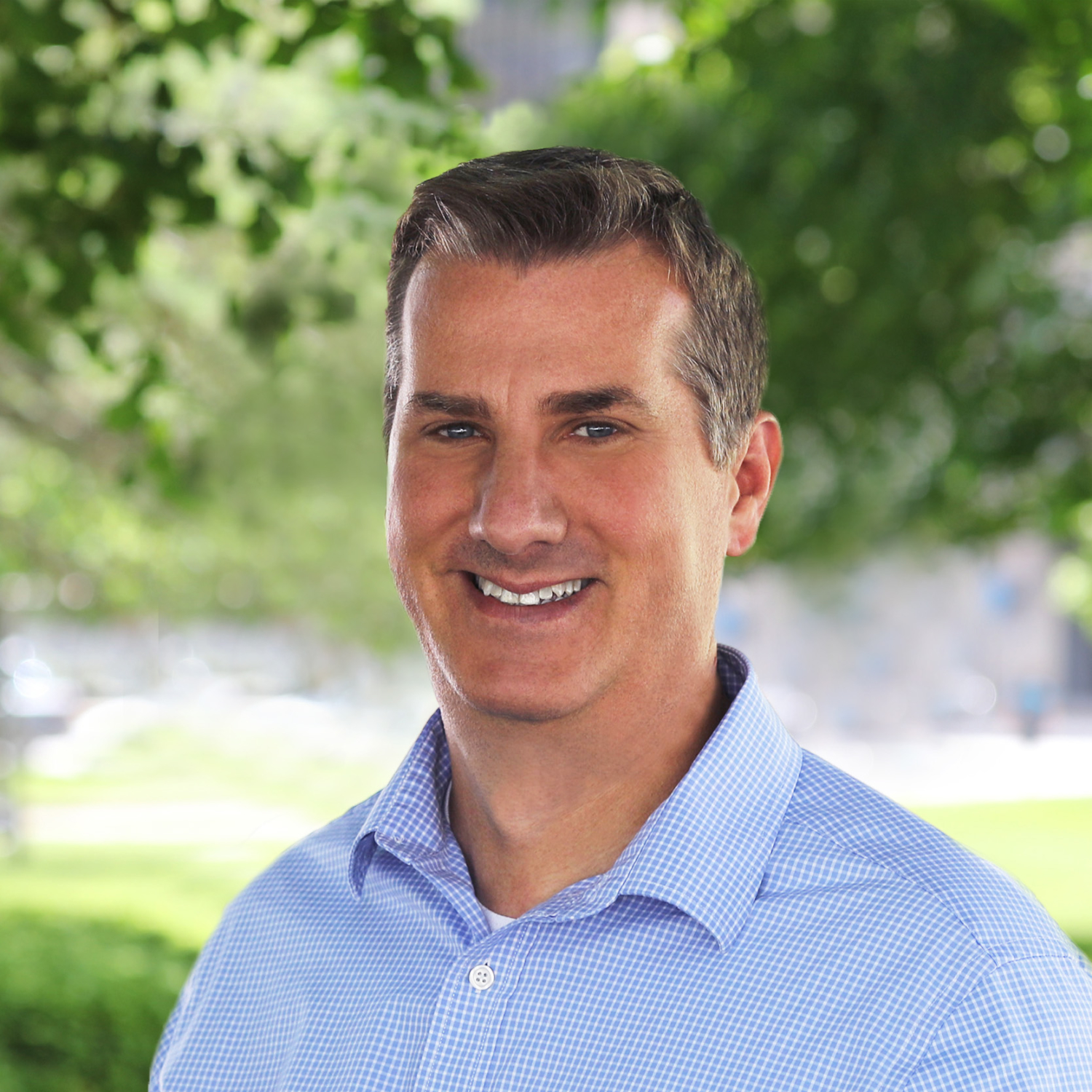EdChoice Public Opinion Tracker: Top Takeaways September 2020
This week we’ve posted reports and our findings based on our most recent survey results that are now posted on EdChoice’s Public Opinion Tracker.
Each quarter Morning Consult conducts two polls on our behalf. The first posed questions to a national sample of K–12 teachers (N = 1,000, in the field September 3–13). A second survey—our monthly tracking poll—was based on a nationally representative sample of adults 18 years and older (N = 2,200, in the field September 11–17). With additional sampling, we obtained responses from 1,261 parents of school-age children so we can report more subgroup demographics with reliability.
In a nutshell: We continue to track COVID-19-related trends. We started asking questions mid-summer about back-to-school readiness, safety and concerns. Recent news stories and opinion pieces have considered the flexibility and equitability of learning pods. What do parents and the public believe and say? Previously, I wrote about the potential value of wide-scale national tutoring effort. In this wave, we asked a new question about the likelihood of seeking out tutoring.
As always, please let me know at paul@edchoice.org if you have any questions about our data or findings, or if you have ideas for new questions or topics.
On to the key findings.
1. About one-third of surveyed parents report they are participating in a learning pod with other families. A slight majority of parents (53%) have either joined a learning pod or are looking to form one. Those with younger children, higher incomes, and living in urban areas are more likely to be participating in pods. Among those participating or looking into pods, they say the arrangements will help students stay up to speed and provide a safe environment for socialization. Whereas those not participating in a pod assert they are unsafe, unnecessary or too expensive.

 2. Seven out of 10 teachers expressed interest in teaching in a learning pod. Sector differences emerge when looking among those “very interested.” Charter school teachers were twice as likely as district school teachers to give that response.
2. Seven out of 10 teachers expressed interest in teaching in a learning pod. Sector differences emerge when looking among those “very interested.” Charter school teachers were twice as likely as district school teachers to give that response.
 3. More than half of school parents are at least somewhat likely to seek out tutoring for their child/children this school year. Three out of 10 said they are “very likely.” Parents who have K–4 students, higher income households ($75K+) and those who are living in urban areas are most likely to seek out tutoring this school year.
3. More than half of school parents are at least somewhat likely to seek out tutoring for their child/children this school year. Three out of 10 said they are “very likely.” Parents who have K–4 students, higher income households ($75K+) and those who are living in urban areas are most likely to seek out tutoring this school year.
 4. Findings on teacher morale are mixed. A little more than half of teachers (54%) indicated they have considered leaving the profession in the last six months. However it doesn’t look like the pandemic’s effects have had a major dampening influence based on our Net Promoter Score question. Yes, there was a dip among the proportion of “promoters” in the summer, but for the full sample of teachers, that group is near again to March-levels. Charter school teachers are the exception. The percentage of promoters in this group has grown to more than half (53%), an increase of 10 points since March. Charter school teachers are much more likely to be promoters of the profession, but at the same time appear slightly more likely than district or private school teachers to want to leave teaching.
4. Findings on teacher morale are mixed. A little more than half of teachers (54%) indicated they have considered leaving the profession in the last six months. However it doesn’t look like the pandemic’s effects have had a major dampening influence based on our Net Promoter Score question. Yes, there was a dip among the proportion of “promoters” in the summer, but for the full sample of teachers, that group is near again to March-levels. Charter school teachers are the exception. The percentage of promoters in this group has grown to more than half (53%), an increase of 10 points since March. Charter school teachers are much more likely to be promoters of the profession, but at the same time appear slightly more likely than district or private school teachers to want to leave teaching.


 5. Most parents are at least somewhat comfortable sending their children in person to school. But they are still more likely to prefer virtual/remote learning if given the option. Based on a series of questions, it’s pretty clear that at least 20 percent of parents do not support their children going back to school in person and would rather facilitate an online learning environment for them. Conversely, it is probably safe to say there is roughly the same proportion who do not want remote learning for their children.
5. Most parents are at least somewhat comfortable sending their children in person to school. But they are still more likely to prefer virtual/remote learning if given the option. Based on a series of questions, it’s pretty clear that at least 20 percent of parents do not support their children going back to school in person and would rather facilitate an online learning environment for them. Conversely, it is probably safe to say there is roughly the same proportion who do not want remote learning for their children.
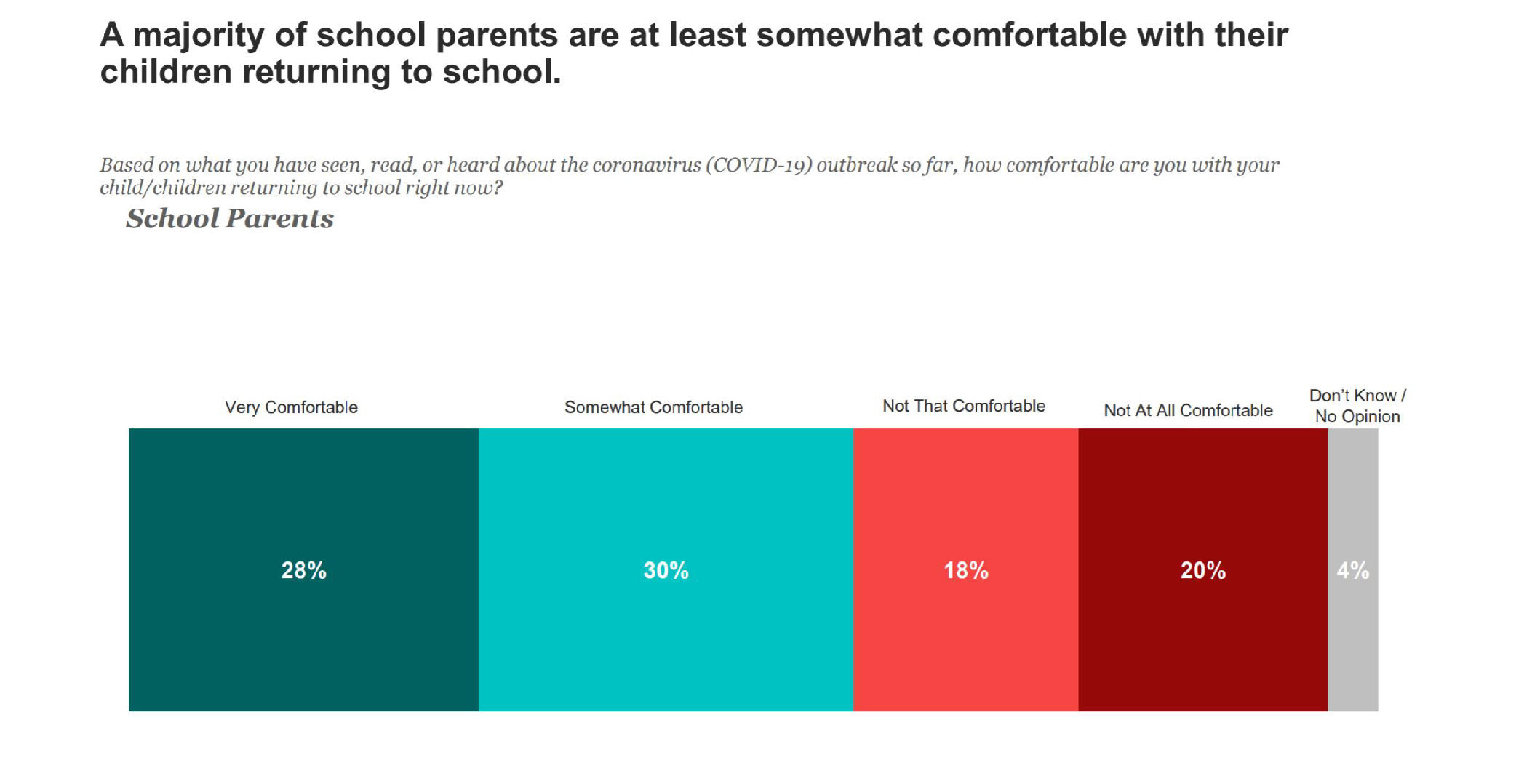
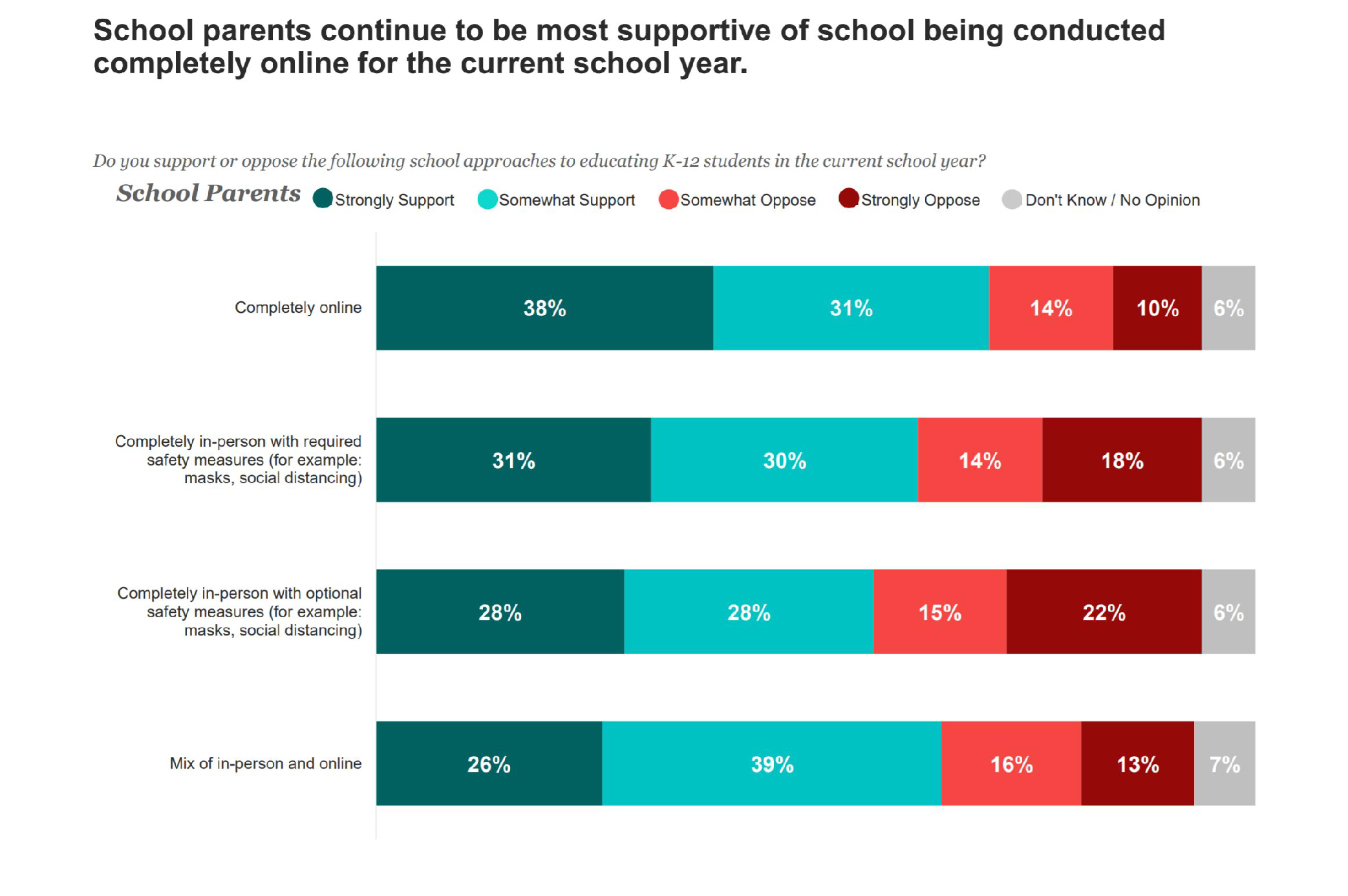
 6. A large majority of parents say they want more than one option for their child’s education. Parents have a range of opinions on children going back to school in person or remote learning, and there seems to be no dominant modal preference. Simply put: Parents want the ability to choose. Two out of three (65%) believe they should have multiple schooling options this year.
6. A large majority of parents say they want more than one option for their child’s education. Parents have a range of opinions on children going back to school in person or remote learning, and there seems to be no dominant modal preference. Simply put: Parents want the ability to choose. Two out of three (65%) believe they should have multiple schooling options this year.
 7. Based on parent reports, one-fifth of students (21%) have switched their child’s/children’s school type since February of this year. School parents with younger children (K–4) are more likely to have switched school sectors than those with older children. It appears that pre-pandemic homeschoolers are the most likely to switch sectors compared to students who were enrolled in other types of schools.
7. Based on parent reports, one-fifth of students (21%) have switched their child’s/children’s school type since February of this year. School parents with younger children (K–4) are more likely to have switched school sectors than those with older children. It appears that pre-pandemic homeschoolers are the most likely to switch sectors compared to students who were enrolled in other types of schools.

 8. Teachers feel more equipped to facilitate online instruction than they did back in June. Though private school and charter school teachers feel more prepared for online instruction, they are more comfortable with returning to school in person than district school teachers.
8. Teachers feel more equipped to facilitate online instruction than they did back in June. Though private school and charter school teachers feel more prepared for online instruction, they are more comfortable with returning to school in person than district school teachers.
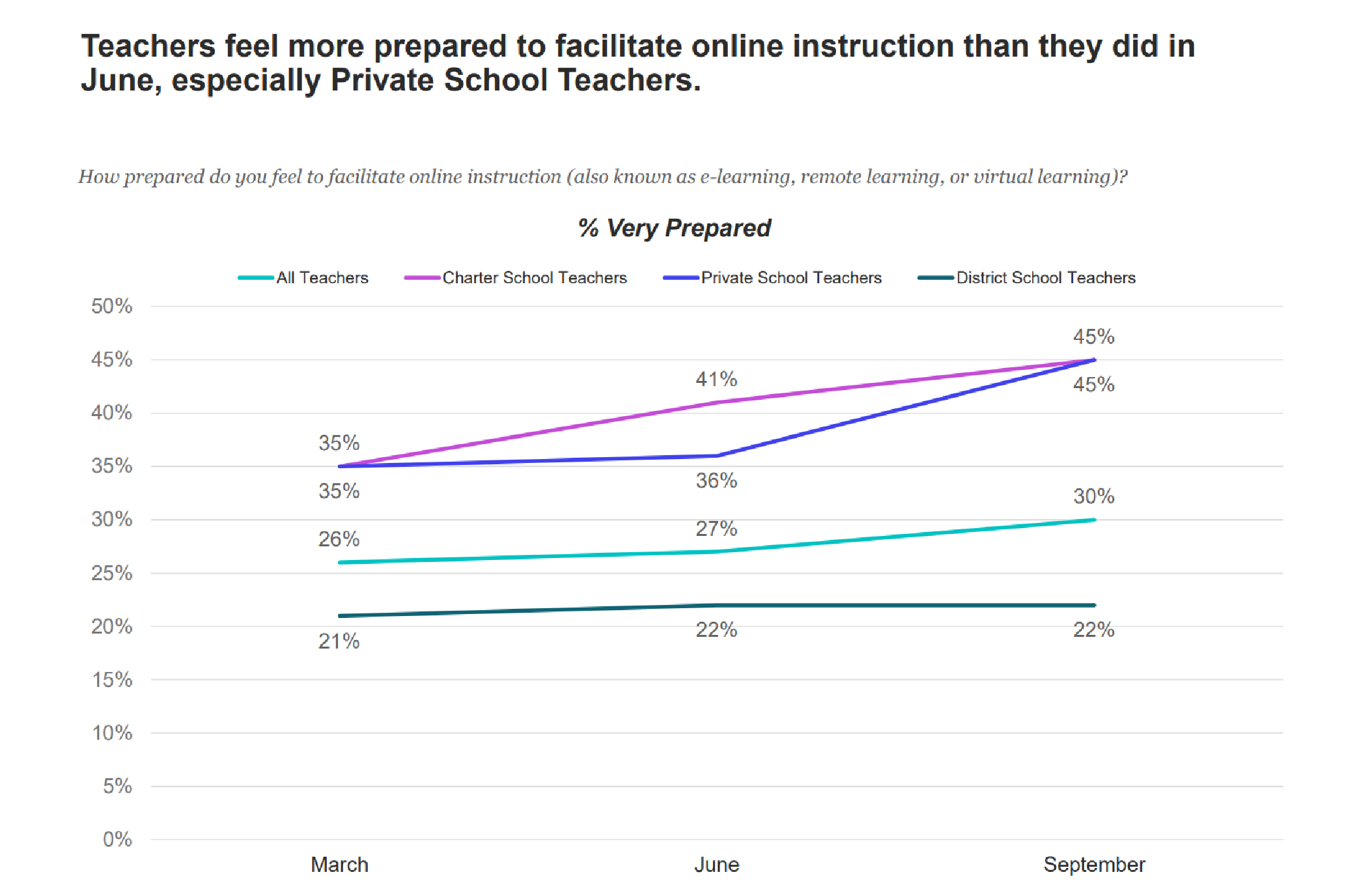
9. Teachers are unsure if it’s safe to go back to school in person for themselves and their students. A plurality strongly support completely online classes this fall and prefer remote learning as a way to keep students and faculty safe and to limit disruption if there is another major outbreak. Those findings also mirror how school parents responded to the same question.
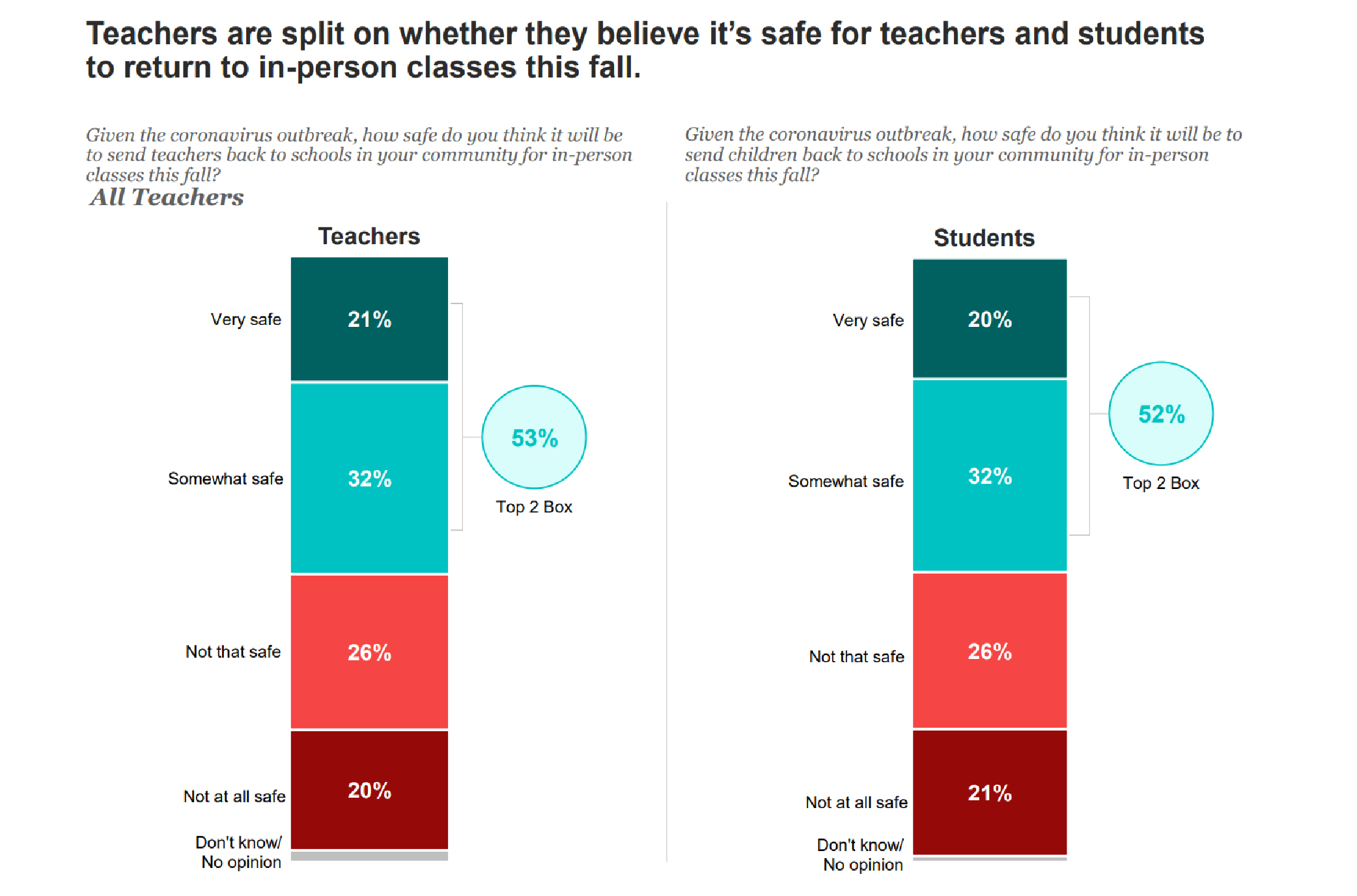
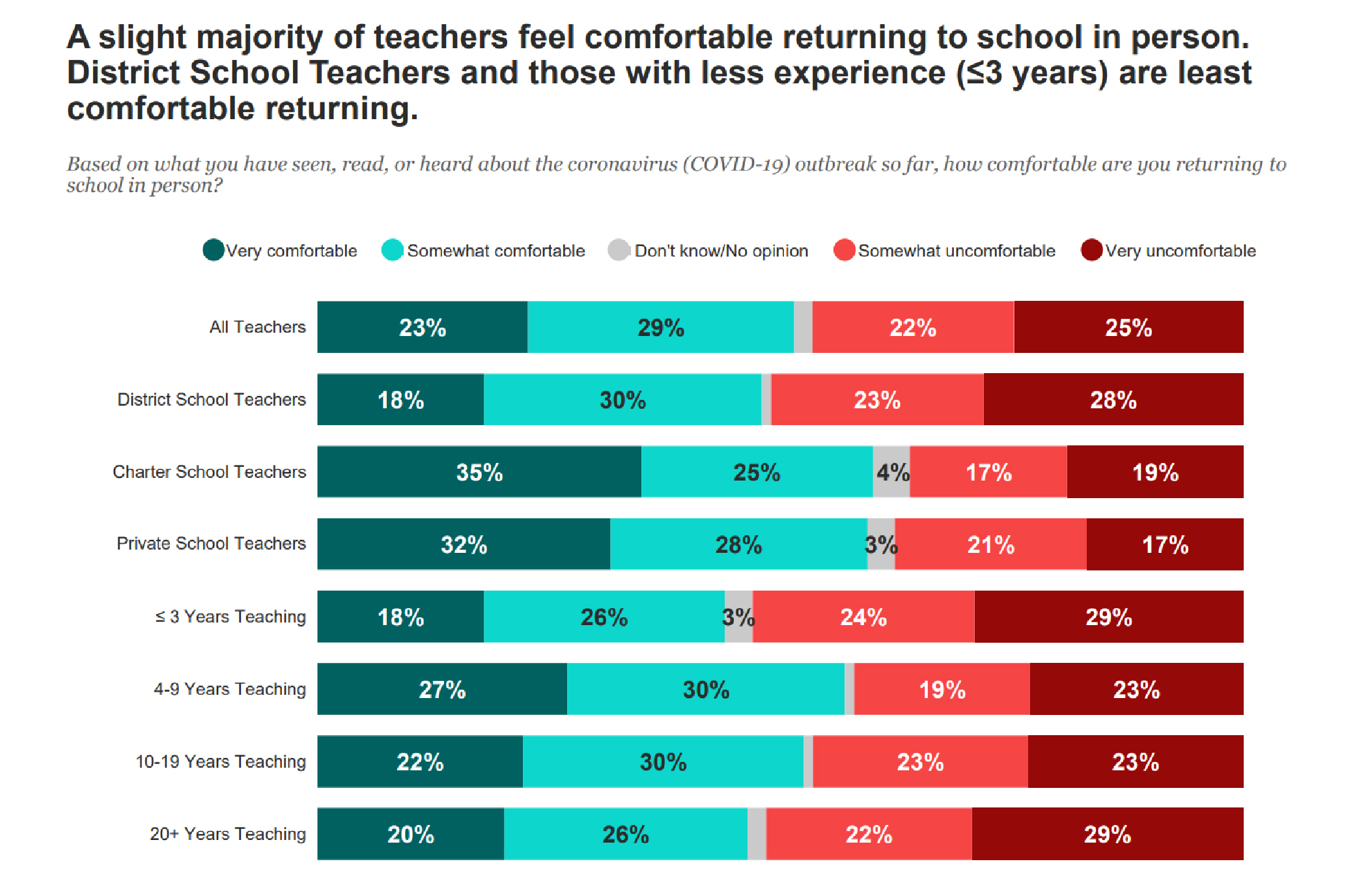
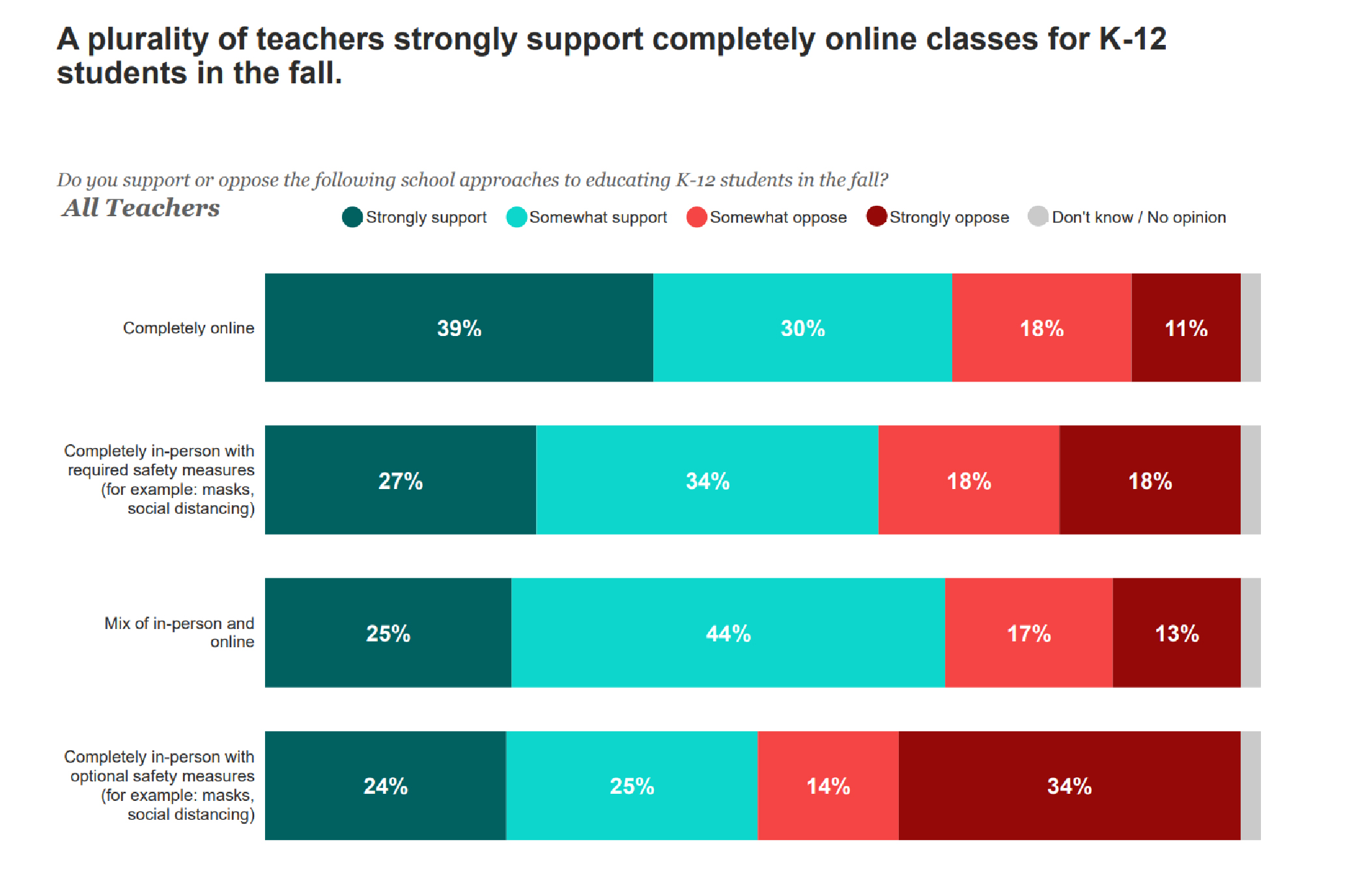
10. Parent favorability for homeschooling continues to remain high and stable. Seven out of 10 parents (70%) say they are at least “somewhat more favorable” toward homeschooling because of the pandemic—and 36 percent said “strongly more favorable” in September. That intensity is down -7 points since July.

11. Parents’ schooling preferences continue to vary widely. They are slightly more likely to say they prefer a public district school based on either of the question versions asked in a split-sample experiment. When the question asks their preferences if transportation and financial costs weren’t factors, middle school and high school parents appear twice as likely to want to homeschool, compared to the base question. Surprisingly—and perhaps inversely related to the homeschool shift—parent preferences for private school go down when the question discounts transportation and financial costs.
 12. Public and parental support have been high for public charter schools, vouchers and education savings accounts during the pandemic, particularly among school parents. It is interesting to note the shifts over time between “strong support” and “somewhat support” for each of these public policy types. Similar to the public and parents, when teachers learn descriptions about these general policies, they are much more likely to express support at higher levels.
12. Public and parental support have been high for public charter schools, vouchers and education savings accounts during the pandemic, particularly among school parents. It is interesting to note the shifts over time between “strong support” and “somewhat support” for each of these public policy types. Similar to the public and parents, when teachers learn descriptions about these general policies, they are much more likely to express support at higher levels.

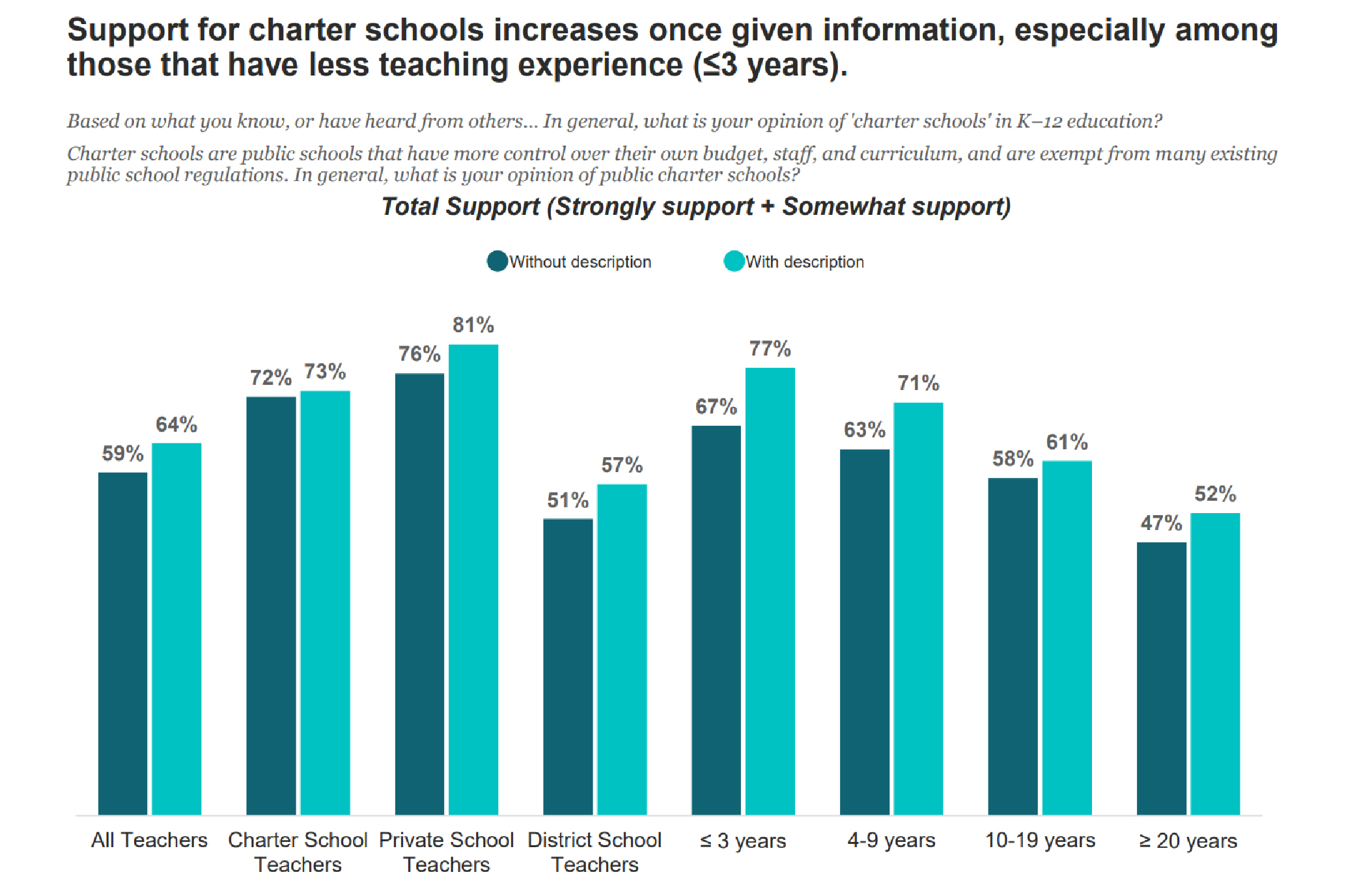

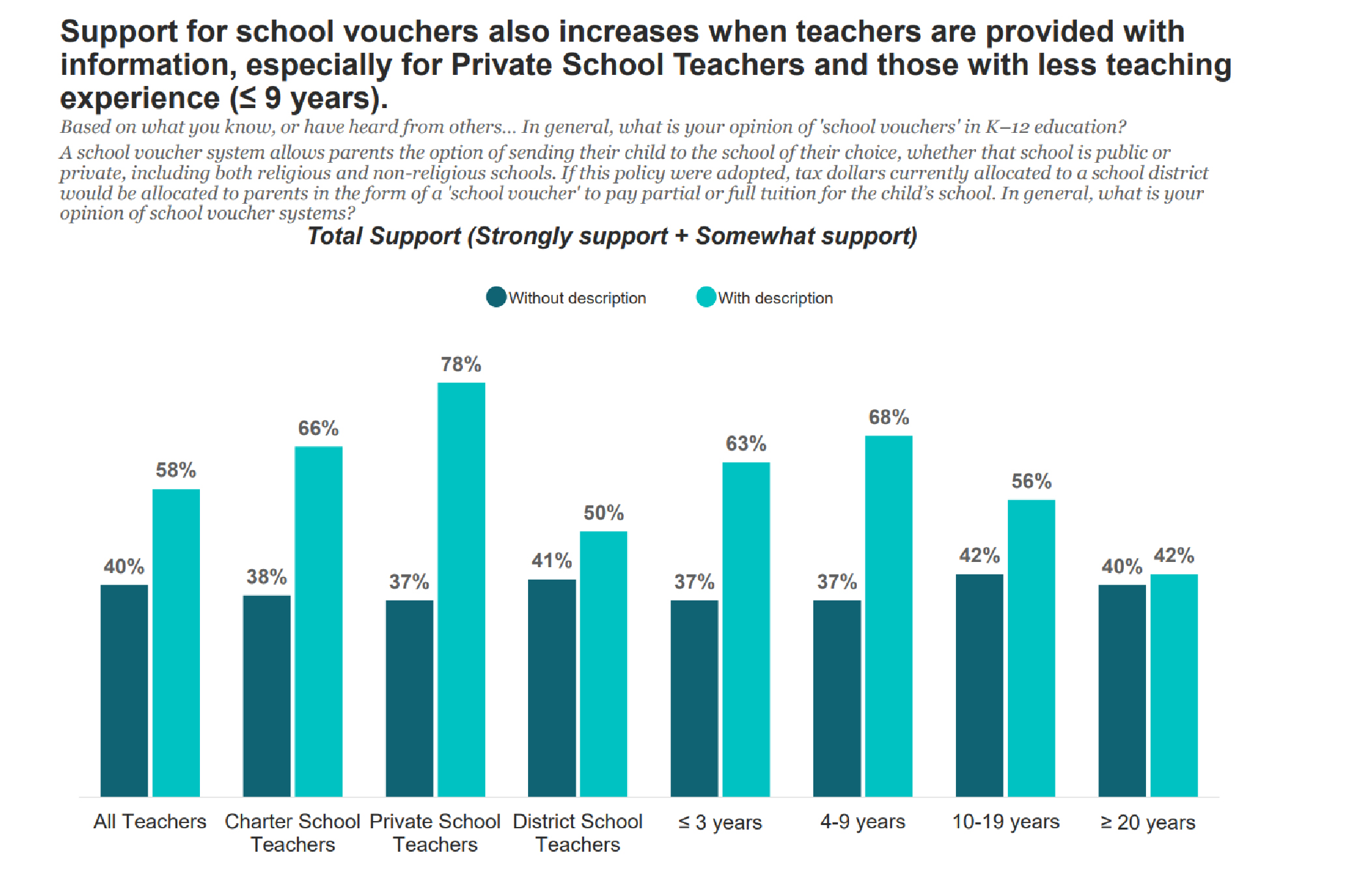

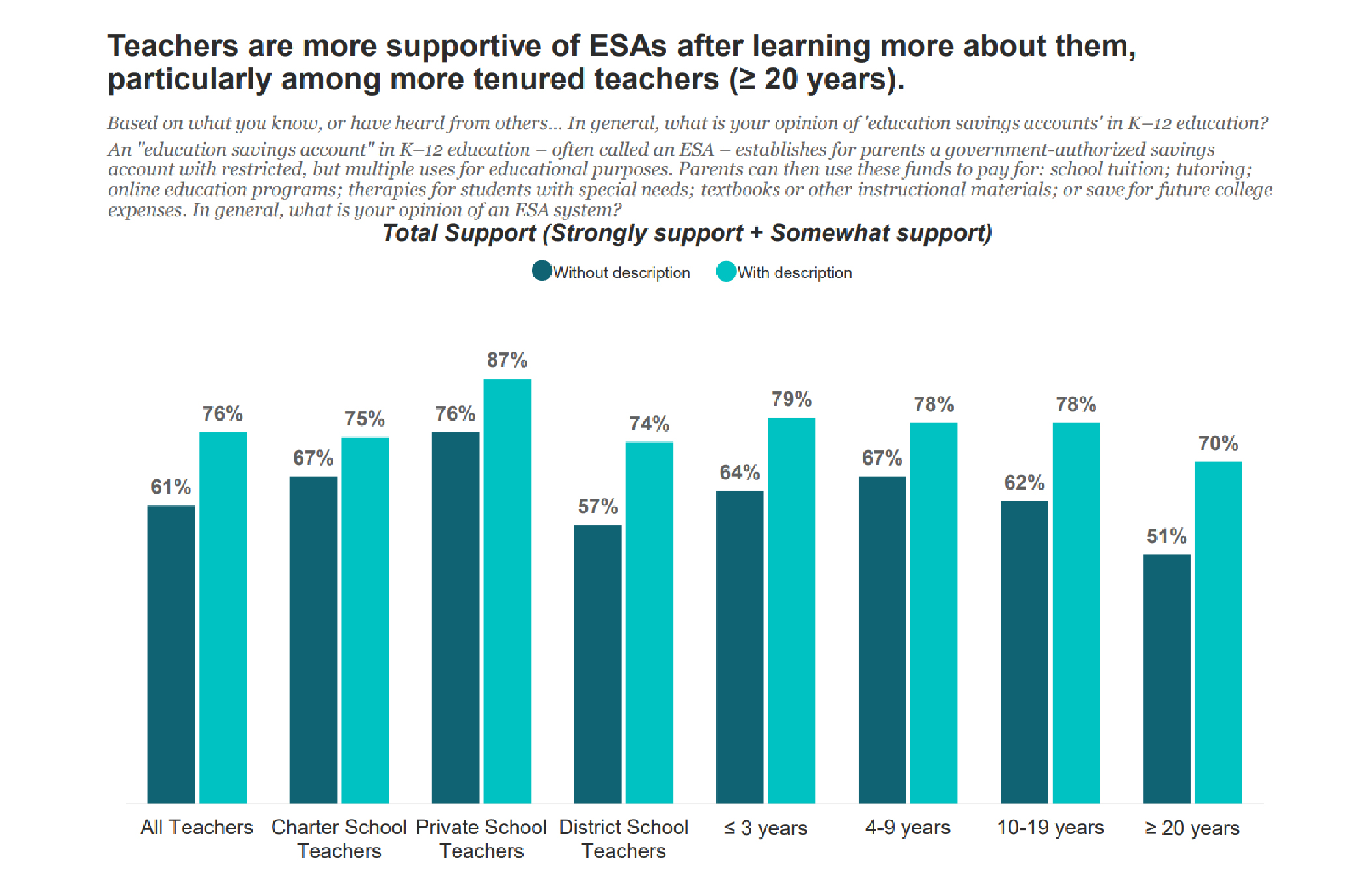
NOTE: A lot of organizations are responding and doing great survey work in the turbulent times we are living in right now. I’ve started to catalog those polls and surveys asking COVID-19 and pandemic questions related to K–12 education. That archive page will be updated on a rolling basis roughly a few times per month or as polls get released. Please don’t hesitate to let me know if I’m missing any to date.


